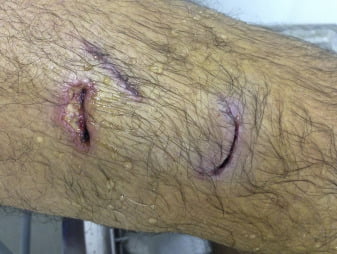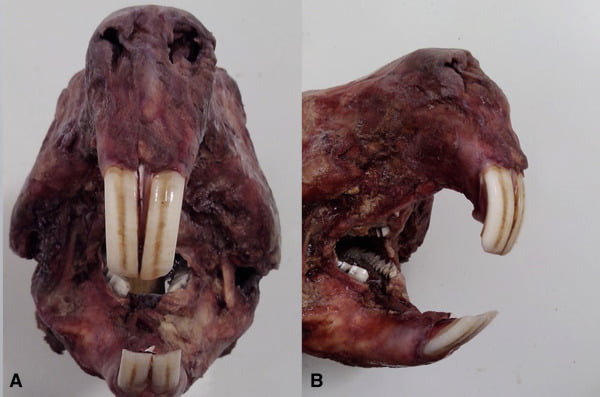Capybara Bite, Capybaras are social and gentle creatures but can become aggressive and bite if they feel threatened. Their large and powerful jaws can cause serious damage to humans. Capybara bites typically happen when people get too close or try to touch them without their permission or come between a mother and her babies.
It is important to understand that these animals are wild creatures and should be treated with respect and caution. They need space, privacy, and a natural environment to thrive. When interacting with capybaras, it is best to observe from afar and not make physical contact unless explicitly allowed by a professional handler.
Despite the aggression shown in biting behavior, capybaras remain an integral part of many ecosystems in South America. As herbivores, they play an essential role in maintaining the balance of plant life in their habitats. In addition to their ecological importance, capybaras are also incredibly intelligent animals that have been known to form strong bonds with both humans and other capybaras.
A famous account of capybara-human bonding comes from the story of “Gary the Capybara.” Gary was a pet capybara who lived with his owners as a member of their family for several years before becoming a public figure on social media platforms like Instagram. Though his fame was short-lived due to his unexpected death, he left behind an admirable legacy for all those captivated by his unique personality traits and charming character.
Capybara bites may not turn you into a werewolf, but the symptoms and health risks can still leave you feeling like a creature of the night.
Symptoms and health risks associated with capybara bites
Capybara bites can lead to various health risks and symptoms that require prompt medical attention. These impacts are not widely known, making it important to understand the potential dangers of these bites. Below are some crucial points to keep in mind when dealing with capybara bites.
- Excessive bleeding: The primary symptom of a capybara bite is profuse bleeding. As such, if you experience any damage to your skin or deep wounds, immediate medical help should be sought.
- Infection: As with any animal bite, infections can set in after a capybara bite. These infections can cause widespread illness and may require hospitalization in severe cases.
- Tetanus: Capybara bites have been known to result in tetanus infections due to bacterial contamination. This complication can affect the nervous system and muscles leading to muscle stiffness, spasms, or seizures.
- Rabies: Though rare, capybaras may be infected with rabies virus causing significant harm when bitten by them. The first few weeks following a capybara bite are crucial for initiating rabies prophylaxis if the animal is found positive for the infection.
- Psychological Impact – Alongside physical harm, a capybara bite may cause psychological issues like fear or irritability resulting from trauma.
It’s critical always to seek medical attention immediately after a capybara bite as it can later result in serious health implications. People who live where capybaras exist should also know how to cope with such adverse events.
A news source has reported an incident when a seven-year-old boy went through intense reactions after repeatedly being bitten by pet Capybaras on his family’s farm near Sydney. The event draws attention to improper behavioral training of domesticated Capybaras that could potentially endanger human lives.
Don’t underestimate the power of a carrot – it may just save you from a capybara’s sharp teeth.
Preventing capybara bites
Capybaras are unpredictable animals, and their bites can be dangerous. To avoid capybara bites, it is crucial to follow safety measures.
Here is a 5-step guide to Preventing capybara bites:
- Give capybaras plenty of space and avoid approaching them.
- Avoid making direct eye contact with a capybara, as they may perceive this as a threat.
- Do not touch or attempt to feed capybaras, as this may lead to aggressive behavior.
- If you encounter a group of capybaras, make sure to keep a safe distance and move slowly around them.
- Always be aware of your surroundings and seek professional help if necessary.
It is important to note that capybaras are social animals, and they can become territorial if they feel threatened or disturbed. It is crucial to respect their boundaries and avoid any actions that may provoke them.
Pro Tip: Never underestimate the strength of a capybara bite. If you are unsure how to approach them safely, seek professional guidance.
Get to know your capybara like the back of your hand, so you can avoid their bite like the back of your friend who owes you money.
Understanding capybara behavior
Capybaras, the largest rodents in the world, have unique behavior that must be understood to prevent injuries or bites. These animals are social and prefer to live in groups. To avoid aggressive behavior, it’s important to never corner them and allow for escape routes. Additionally, they can become territorial when stressed or threatened.
It’s crucial to recognize the signs of stress in capybaras, such as tail flicking or vocalizations. They also tend to communicate with each other through scent-marking and grooming behaviors. Understanding their behavior patterns can help prevent harm to both humans and capybaras.
Lastly, always follow safety precautions around capybaras, such as avoiding feeding them human food and seeking medical attention immediately if bitten. Being aware of how capybaras behave is not only necessary for personal safety but also ensures respect and protection for these fascinating creatures.
Don’t miss out on learning more about how to safely interact with capybaras by taking the time to understand their behavior! Handle with care, or you may end up with a copy-bite-a.
Proper handling and interaction with capybaras
Handling and interacting with capybaras requires adequate knowledge and understanding of their behavior. Approach them calmly and avoid sudden movements or loud noises, which may trigger aggression. Reinforce positive behavior with treats, but do not force interaction if they are not comfortable. Respect their space and try to maintain a safe distance at all times.
It is crucial to monitor interactions between capybaras and humans, especially during feeding sessions, as it might provoke aggressive tendencies in these animals. It is best to feed them from a distance or through the barrier without any physical contact. Additionally, capybaras are social animals and thrive better in groups; avoid keeping a lone capybara as it might lead to stress or anxiety.
Remember that while capybaras can be friendly and affectionate pets when handled correctly, they still possess sharp teeth that can cause serious injuries. Therefore, avoid placing your fingers or any body part near their mouth region without supervision.
Pro Tip: Always consult with trained professionals for guidance on handling and interaction techniques with Capybaras before attempting any such activities yourself.
Who knew keeping capybaras in appropriate enclosures could prevent not only escaped rodents but also accidental bites – it’s a win-win situation for both the animal and your fingers.
Keeping capybaras in appropriate enclosures
Capybaras require adequate living space to prevent bites. Providing an appropriate enclosure with enough room, ventilation, and shade is crucial. The enclosure should replicate the capybara’s natural habitat with access to water, plants, and soil.
Capybaras are semi-aquatic animals that need to be able to swim and soak in water regularly, so the enclosure must have a pool or large water source. It’s also important to ensure that the fence or walls of the enclosure are high enough so that capybaras cannot jump out.
To keep capybaras from becoming aggressive, provide them with plenty of toys and objects to chew on. Capybaras may become bored if they do not have something to occupy their time, which can lead to destructive behavior.
In Japan, where capybaras are considered sacred animals, some hot-spring baths cater specifically for these creatures by providing dedicated pools for them to use along with human guests.
Creating a suitable environment for your pet capybara is key in preventing bites and ensuring their overall health and happiness.
Who knew that getting bitten by a giant rodent could be a real problem? Looks like it’s time to stock up on some capybara repellent.
Treating capybara bites
When dealing with capybara bites, prompt medical attention is crucial. Rinse the wound with clean water and apply pressure to control the bleeding. Do not apply ointments or gels unless directed by a medical professional. In case of infection, antibiotics may be prescribed after evaluation. It is important to note that capybaras are wild animals and should not be approached or provoked. Seek medical help immediately if bitten.
Additionally, it is recommended to have a tetanus shot if the bitten person has not received one recently. It is also important to keep the wound clean and dry to prevent further infection.
Pro Tip: It is always best to avoid interactions with wild animals and not approach or get too close to them. If an encounter is unavoidable, keep a safe distance and do not provoke them.
If you find yourself on the wrong end of a capybara’s bite, don’t panic – just remember to apply first aid and avoid any future awkward encounters at the local zoo.
First-aid measures for capybara bites
When tending to bites from capybaras, the first-aid measures include:
- Cleaning the wound thoroughly
- Applying pressure to stop bleeding
- Using antibiotic ointment
It’s also important to watch out for signs of infection or allergic reactions. Seek medical attention if necessary.
Additionally, it’s crucial to understand that capybaras are wild animals and should not be approached or provoked. Remember that bites from any wild animal can carry diseases or infections, so use caution when encountering them.
If a bite occurs, it’s essential to remain calm and seek medical attention promptly. Delaying treatment can lead to more severe complications down the line.
A friend once shared their story about an encounter with a capybara in the wild. Despite being warned by locals about the animal’s potential aggression, they attempted to get close for a photo op and were bitten as a result. With quick thinking and proper care, they were able to avoid any severe complications. However, they learned an invaluable lesson about respecting wildlife and staying safe in unfamiliar environments.
Looks like the capybara wanted a piece of you, but with the right medical treatment, you’ll come out on top of the food chain again.
Medical treatment for severe capybara bites
In case of severe bites from capybaras, immediate medical attention is crucial. The wound should be cleaned and disinfected thoroughly to prevent infection. Tetanus vaccination should be given if necessary, and antibiotics may be prescribed by a healthcare professional. It is also important to keep the wound covered and to monitor for any signs of infection.
For less severe bites, pain relief medication such as paracetamol can help ease discomfort. The wound should still be cleaned and monitored for any signs of infection. If there are any concerns or worsening symptoms, seek medical advice immediately.
It is critical to remember that capybaras are wild animals, and no matter how friendly they may seem, approaching them can still pose a risk. Always exercise caution when nearby and avoid unnecessarily provoking or antagonizing them.
A true fact: Capybaras are considered to be the largest rodents in the world according to National Geographic.
Before owning a capybara, make sure you fully understand the legal responsibilities of owning a creature that can easily pass for a dog in a mud bath.
Legal Considerations and Responsibilities for Owning Capybaras
Owning capybaras requires adequate knowledge of the legal considerations and responsibilities involved. Prospective owners must be familiar with regional regulations and licensing requirements. Additionally, they are responsible for ensuring that their animals are well-cared for, housed and secured appropriately, as well as educating themselves on proper handling techniques and precautions to prevent possible injury and disease. Failure to adhere to these guidelines can result in hefty penalties or even legal action.
In areas where these animals are not native, permits may be required before ownership or transportation is permitted. Owners must comply with state regulations regarding animal importation, possession, and transportation carefully. Depending on your location jurisdiction, owning a capybara could require certain standards for fencing or housing built out near them.
It’s essential to ensure that environmental temperature conditions for capybaras are continuously monitored as changes in weather can adversely affect their health. Be sure to provide access to clean water sources to keep the animal hydrated at all times.
Furthermore, ensure that your animal receives regular veterinary care if it gets sick or injured. Obtain reliable information from trusted experts on basic care needs such as diet & nutrition, and dental hygiene as prevention against bite infections.
Finally, out of a decision made by emotion, a bar owner purchased two Capys without having earlier knowledge about them. This became a threat to the visitors’ safety after one of them bit a child, leading officials to seal up the bar until reliable housing was situated for the animals. Remember, owning a capybara comes with great responsibility – or else you might end up with a bite that’s bigger than the rodent itself!
Conclusion: Importance of responsible ownership and interaction with capybaras
Responsible ownership and interaction with capybaras are crucial to avoid any mishappenings like a capybara bite. Owning a capybara requires adequate knowledge of their behavior, diet, and habitat. Maintaining a healthy relationship with them demands regular exercise routines and providing them with a clean living environment. Educating yourself about the handling techniques will help prevent any aggressive behavior from these social animals. Remember, capybaras are creatures of habit and thrive on consistency in environment and schedule.
Frequently Asked Questions
1. What are capybaras?
Capybaras are large rodents found in South America.
2. Do capybaras bite?
Yes, capybaras can bite if they feel threatened or cornered.
3. Is a capybara bite dangerous?
Capybara bites can result in infections or lead to diseases such as salmonella. It is important to seek medical attention if bitten.
4. What should I do if I am bitten by a capybara?
Wash the wound thoroughly with soap and water and seek medical attention immediately.
5. Can I keep a capybara as a pet?
It is illegal in some countries to keep capybaras as pets. Additionally, they are social animals and require special care and attention that may not be suitable for everyone.
6. How can I avoid being bitten by a capybara?
Avoid approaching or cornering capybaras, especially in their natural habitats. If necessary, seek the guidance of a professional guide or caretaker.


.jpg)

